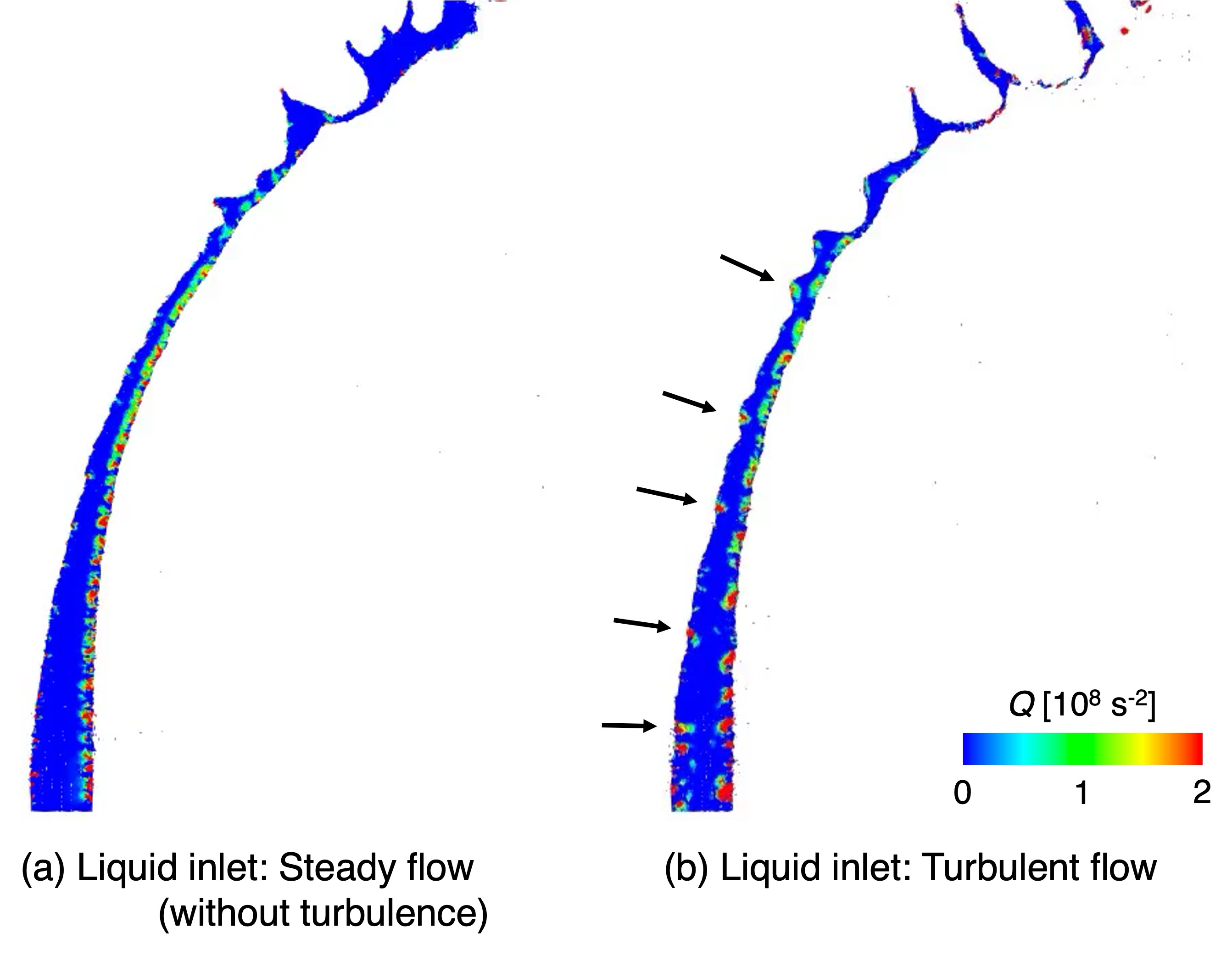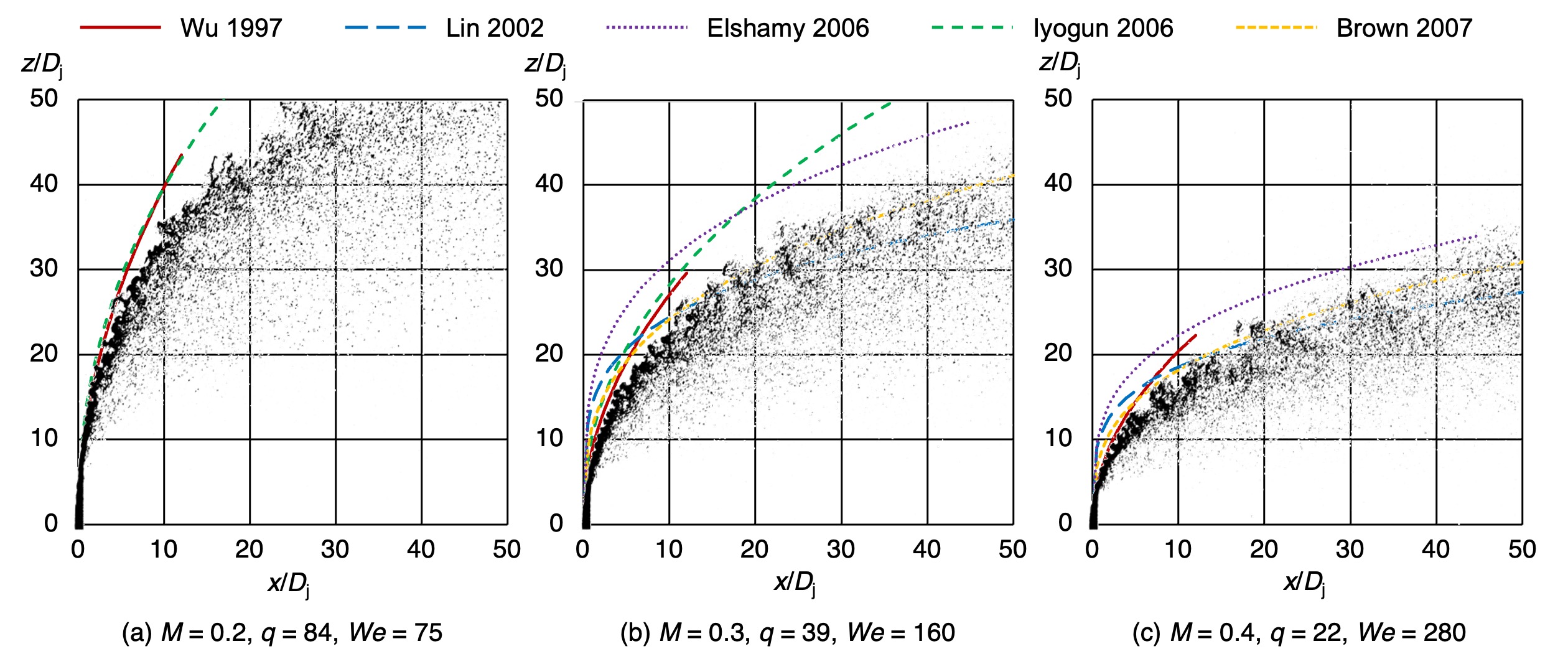Research on particle-grid hybrid analysis method
JAXA Supercomputer System Annual Report February 2022-January 2023
Report Number: R22ECWU03
Subject Category: Cooperative Graduate School System
- Responsible Representative: Yasuhiro Mizobuchi, Aviation Technology Directorate, Aircraft Lifecycle Innovation Hub
- Contact Information: Hiroki Tsujimura (Waseda University)(hiroki-tsujimura@toki.waseda.jp)
- Members: Hiroki Tsujimura
Abstract
In this project, we study the particle-grid hybrid analysis method, a novel method suitable for numerical analysis of liquid fuel atomization. In the method, liquid is calculated by a particle method (the moving particle simulation (MPS) method using JAXA's software "P-flow"), while gas is calculated by a grid method (the finite volume method using JAXA's software "FaSTAR"), and the two phases are coupled by the aerodynamic force model developed by the users. The validity of the particle-grid hybrid analysis method is evaluated through calculations of liquid jet breakup in gas crossflow.
Reference URL
N/A
Reasons and benefits of using JAXA Supercomputer System
We used JSS3 because calculations of liquid jet breakup require high calculational performance, especially in terms of memory and interprocess communication. First, the number of particles and grid cells were approx. 10 million respectively in a typical calculation of this year, and we plan to increase them in future work. Second, our analysis program at present consumes a large amount of memory because two different Cartesian grids, the first one called "buckets" that is used to manage particles and the second one used to exchange flow data between the particle and grid methods, need to be allocated. Third, the amount of interprocess communication due to the particle-grid coupling process is large because the region decomposition of the particle/grid methods do not match with each other. In order to accelerate our research under these circumstances, we decided to use a supercomputer.
Achievements of the Year
This year, we had two major achievements. First, we proposed a novel surface tension model for free flow analylses by the MPS method, called the surface tension as pressure (STP) model, in which the effect of surface tension is considered as a pressure boundary condition at the liquid surface. The STP model was validated through calculations of a stationary spherical droplet and an oscillating elliptic droplet (publication [1]). Second, we calculated liquid jet breakup in gas crossflow at various physical conditions in order to investigate the applicability of the particle-grid hybrid analysis method at those conditions. Applying turbulence to the liquid's inlet velocity improved the results by promoting breakup of the liquid column (Fig. 1, publication [2]). The breakup regimes of the liquid column, namely bag, multimode, and sheet-thinning, were reproduced at their corresponding Weber numbers, where using the STP model improved the results. The liquid column's trajectory and the spray distribution were qualitatively close to experiments at several liquid-to-gas momentum ratios (Fig. 2, publication [3]).

Fig.1: Cross section of a liquid column colored by the second invariant of velocity gradient tensor. When a turbulent flow was given to the inlet (b), vortices enhanced the amplification of the waves on the liquid column surface (Rayleigh-Taylor instability), as shown by arrows in the figure

Fig.2: Overall view of liquid jet breakup in gas crossflow at different physical conditions. Curves are experimental correlations of the liquid jet's trajectory (windward side)
Publications
- Peer-reviewed papers
[1] Tsujimura, H., Kubota, K., Sato, T., Applying surface tension as pressure boundary condition in free surface flow analysis by moving particle simulation method, Computational Particle Mechanics, Mar 2023. DOI: 10.1007/s40571-023-00575-0
- Oral Presentations
[2] Tsujimura, H., Kubota, K., Sato, T., Numerical analysis of turbulent liquid jet using particle-grid hybrid method, 27th JSCES Conference, A-05-04, Jun 2022 (in Japanese).
[3] Tsujimura, H., Kubota, K., Sato, T., Particle-grid hybrid analysis of liquid jet primary breakup in gaseous crossflow, 11th Asia Joint Conference on Propulsion and Power, AJCPP2023-095, Mar 2023.
- Other
Tsujimura, H., Modeling aerodynamic force and surface tension for particle-grid hybrid analysis of liquid atomization, Doctoral Dissertation, Waseda University, Feb 2023.
Usage of JSS
Computational Information
- Process Parallelization Methods: MPI
- Thread Parallelization Methods: N/A
- Number of Processes: 1 - 288
- Elapsed Time per Case: 72 Hour(s)
JSS3 Resources Used
Fraction of Usage in Total Resources*1(%): 0.11
Details
Please refer to System Configuration of JSS3 for the system configuration and major specifications of JSS3.
| System Name | CPU Resources Used(Core x Hours) | Fraction of Usage*2(%) |
|---|---|---|
| TOKI-SORA | 0.00 | 0.00 |
| TOKI-ST | 875059.99 | 0.87 |
| TOKI-GP | 0.00 | 0.00 |
| TOKI-XM | 0.00 | 0.00 |
| TOKI-LM | 3.71 | 0.00 |
| TOKI-TST | 0.00 | 0.00 |
| TOKI-TGP | 0.00 | 0.00 |
| TOKI-TLM | 0.00 | 0.00 |
| File System Name | Storage Assigned(GiB) | Fraction of Usage*2(%) |
|---|---|---|
| /home | 166.67 | 0.15 |
| /data and /data2 | 2666.67 | 0.02 |
| /ssd | 33.33 | 0.00 |
| Archiver Name | Storage Used(TiB) | Fraction of Usage*2(%) |
|---|---|---|
| J-SPACE | 0.00 | 0.00 |
*1: Fraction of Usage in Total Resources: Weighted average of three resource types (Computing, File System, and Archiver).
*2: Fraction of Usage:Percentage of usage relative to each resource used in one year.
ISV Software Licenses Used
| ISV Software Licenses Used(Hours) | Fraction of Usage*2(%) | |
|---|---|---|
| ISV Software Licenses(Total) | 0.00 | 0.00 |
*2: Fraction of Usage:Percentage of usage relative to each resource used in one year.
JAXA Supercomputer System Annual Report February 2022-January 2023


